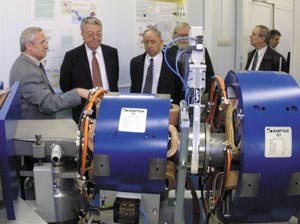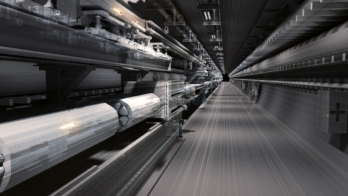Established to pursue fundamental science, both CERN and its Russian counterpart JINR have an important role in breaking down international barriers. This succeess is now providing a model for a third organization in the Middle East.
CERN and the Joint Institute for Nuclear Research (JINR) in Dubna are celebrating their 50th anniversaries within a year and a half of each other. During the past 50 years both centres have become famous for their first-class achievements at the forefront of natural science – the origin and structure of the universe. Their fundamental results have been achieved through the joint efforts of scientists from many countries, who were united by one common goal – to gain new knowledge about nature and to enhance their understanding of it. At the same time these efforts have also helped bring together nations of widely differing cultures.

It was in 1949 at the European Cultural Conference in Lausanne, Switzerland, that the distinguished French scientist Louis de Broglie first proposed the idea for a European research laboratory: “…Our attention has turned to the question of developing this new international unit, a laboratory or institution where it would be possible to carry out scientific work above and beyond the framework of the various nations taking part…This body could be endowed with greater resources than those available to the national laboratories and could then embark upon tasks whose magnitude and nature preclude them from being done by the latter on their own.” The following year Isidor Rabi took up this theme at the Fifth General Conference of UNESCO (the United Nations Educational, Scientific and Cultural Organization), and a series of meetings held under the auspices of UNESCO led ultimately to the establishment of CERN in 1954 (CERN Courier October 2004 p11).
CERN has since evolved to become the world’s largest particle-physics laboratory, exploring some of nature’s most fundamental questions. Today CERN’s membership comprises 20 European countries, and more than half the world’s particle physicists use CERN’s facilities. This international collaborative effort has enabled CERN to become greater than the sum of its parts and a centre of excellence in research. Over the years the accelerator complex has allowed many discoveries by researchers at CERN, including in the 1970s the discovery of weak neutral currents and in the 1980s the W and Z bosons that carry the weak interaction. In the 1990s the Large Electron Positron collider (LEP), in a tunnel 27km in circumference and 100 m underground, contributed significantly to establishing the current Standard Model of particles and their interactions. Now LEP has been dismantled and the Large Hadron Collider (LHC) is being installed in its place.
The LHC project, including its four major detectors, is being implemented by the efforts of more than 400 research laboratories from dozens of countries around the world. These include Russia, which as an observer state of CERN is actively participating in the LHC construction and experiment collaborations. Around 20 scientific institutions belonging to various agencies and more than 30 industrial enterprises from Russia are involved in the work on this large-scale project.
Russia also has its own succeess story in fundamental research and international collaboration. JINR, located in the picturesque town of Dubna on the bank of the Volga river, has been closely collaborating with CERN for nearly half a century. The first contacts began in the mid-1950s, immediately after the foundation of JINR in 1956, with conferences and the first visits of scientists. In 1958 the distinguished Russian physicist Nikolai Nikolaevic Bogoliubov, director of the JINR Laboratory of Theoretical Physics, suggested that there should be systematic exchanges of scientists between JINR and CERN. This idea was given impetus at an informal meeting on international co-operation in the field of high-energy accelerators held at CERN in 1959, which was attended by senior scientists from the US, Russia and Western Europe. In the 1960s and 1970s co-operation with CERN was developed further with the organization of joint seminars, summer schools for young scientists and a wider exchange of scientists.
During the 48 years of its existence JINR, like CERN, has played the role of a bridge between East and West, contributing to the development of international scientific co-operation among dozens of countries. Now JINR has scientific relations with nearly 700 research centres and universities in 60 countries.
In the early 1990s, after the disintegration of the USSR, JINR entered a new stage of its development. Eighteen countries became its member states, and bilateral agreements at governmental levels were concluded with Germany, Hungary and Italy. In 1992 JINR established an international scientific council, whose membership included leading scientists from the world’s largest research laboratories. Independent and international programme advisory committees were also established. For the first time representatives of the JINR member states have been able to indicate which specific fields of research were for them the most interesting and important.

JINR today offers a unique choice of experimental facilities: the Nuclotron, which is the only superconducting accelerator for nuclei and heavy ions operating in Russia; the U400 and U400M cyclotrons with record beam parameters, which are used for experiments on the synthesis of heavy and exotic nuclei; the unique pulsed neutron reactor IBR-2, and the Phasotron, a proton accelerator used for hadron therapy. JINR also has powerful and high-performance computing facilities integrated into the global computing network.
As a recognition of the achievements of JINR’s research staff, in 1997 the International Committee of Pure and Applied Chemistry awarded the name “Dubnium” to element 105 of the periodic table. The international scientific community was impressed by the experiments carried out during 1999-2003 at the U400 cyclotron of the JINR Flerov Laboratory of Nuclear Reactions on the synthesis of new elements with atomic numbers 114, 116, 118, 115 and 113. Today JINR is a world-recognized leader in this area of research.
In the past few years the positive experiences accumulated by CERN and JINR in overcoming political barriers through mutually beneficial scientific co-operation has been succeessfully used in the development in Jordan, again under the auspices of UNESCO, of a new international centre for research and advanced technology “in the image and likeliness of CERN and JINR”. The Synchrotron light for Experimental Science and Applications in the Middle East (SESAME) project will produce synchrotron radiation over a broad range of wavelengths from the infrared to X-rays, with various fields of application (CERN Courier November 2002 p6). Its participants include Israel, the Palestinian National Authority, Iran, Jordan, Turkey, Egypt and other countries. The president of the council of the SESAME centre is German physicist Herwig Schopper, who is playing the key role in the realization of this project. In the past Schopper served as CERN director-general (1981-1988), and was president of the European Physical Society (1994-1996) and a member of the JINR Scientific Council (1993-2002). He was awarded the Russian Order of Friendship in 1997.
The establishment of the new international SESAME centre will not only make a significant contribution to the scientific, technical and economic development of the Middle East countries but will also undoubtedly promote the coming together of the people of this region, the mutual understanding of people with different traditions, religious and political views, and, hopefully, the peaceful settlement of existing conflicts.
SESAME is thus set to continue the tradition of co-operation begun by CERN and JINR, who are justly called a “permanently operating peace congress”, as they have never stopped their extensive collaboration, even during the gloomiest years of the Cold War. Today, the world at large recognizes that the major merits of JINR and CERN are not only their remarkable achievements in the field of basic science but also their extremely important contributions to the rapprochement and understanding among nations. By their practical activities over the decades these two international laboratories have proved that the fundamental principles that were declared at their foundation, namely the openness and peaceful nature of joint scientific research, the equality of all member states, and wide applications of scientific results for the benefit of mankind, have turned out to be most profound, humane and promising for the future.





